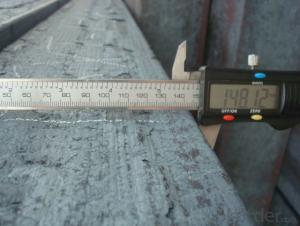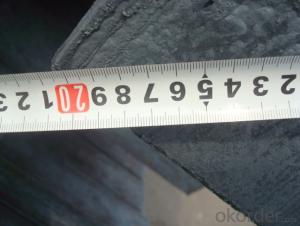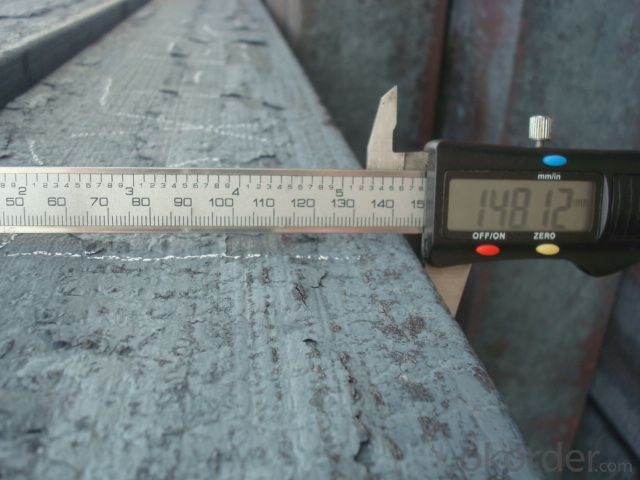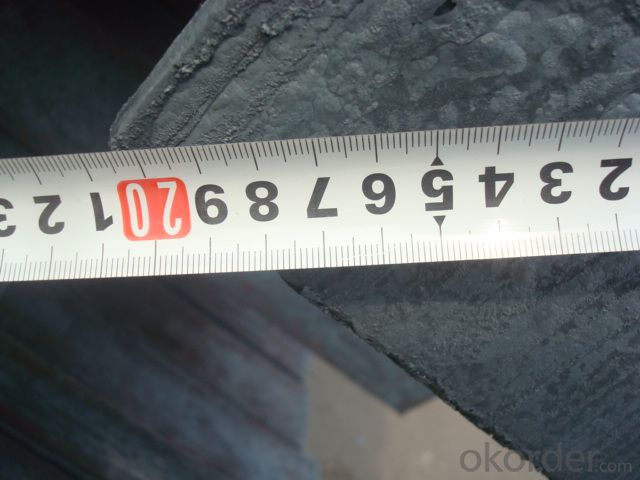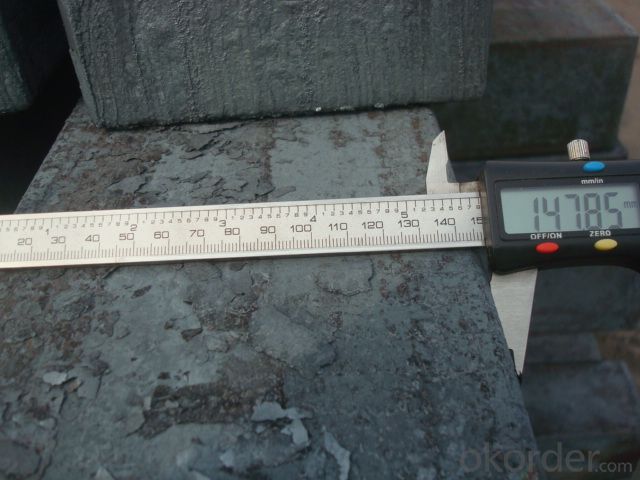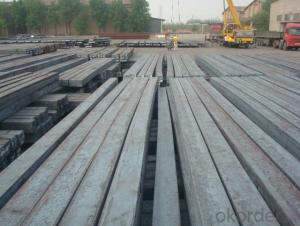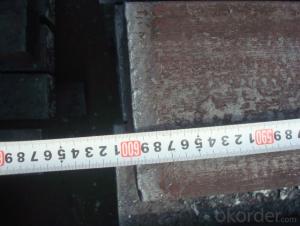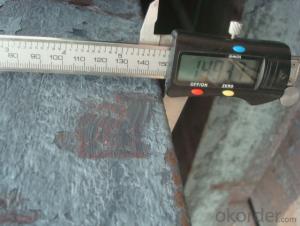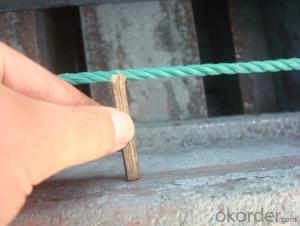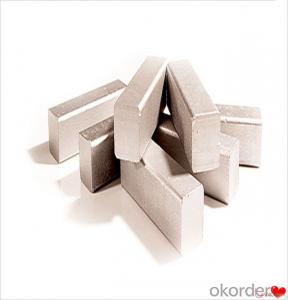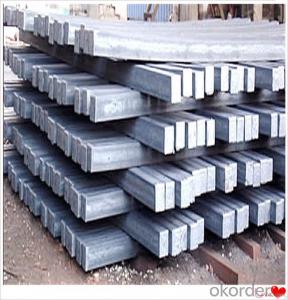Prime Steel Billet Q275, 20MnSi, 5SP,Q235
- Loading Port:
- Tianjin
- Payment Terms:
- TT OR LC
- Min Order Qty:
- 1000 m.t.
- Supply Capability:
- 20000 m.t./month
OKorder Service Pledge
OKorder Financial Service
You Might Also Like
STEEL BILLET
1.Brief description
Steel billet(ingot) by cogging or breakdown of semi-finished products, is the raw material of all kinds of steel mill. Billet section of square, round, flat, rectangular and abnormity of several kinds of, mainly related to the shape of rolled products.
2.Features
Rectangular billet continuous casting billet and mainly general carbon steel, low carbon low silicon cold-rolled material, high quality carbon structural steel, high strength low alloy steel, special steel, etc.
The billet is mainly divided into two kinds from the shape:
Slab: cross section width and height of the ratio of the larger, mainly used for rolling plate.
Billet: equal cross section width and height, or a huge difference, mainly used for rolling steel, wire rod. ,
Steel billets have distinct characteristics as compared with already furnished steel bars and products. Billets have a specific grain structure, which enables the metal to be processed more intricately. Steel billets are also known for their malleability and ductility, especially when exposed to varying temperatures during shaping and molding.
3.Processing
Steel billets are considered fresh and raw, and they must undergo a series of manufacturing processes before they can be used for various purposes. Billets are made by means of freezing molten liquid, and are later exposed to extremely low temperatures in order to allow the metal to take shape and solidify in chemical structure. The temperature manipulates the metal's physical properties, and tones its strength and durability. The subsequent processes provide the metal's curved mold design so that it can fit the allotted space provided by other machines, which complete the finishing procedures.
4.Pictures
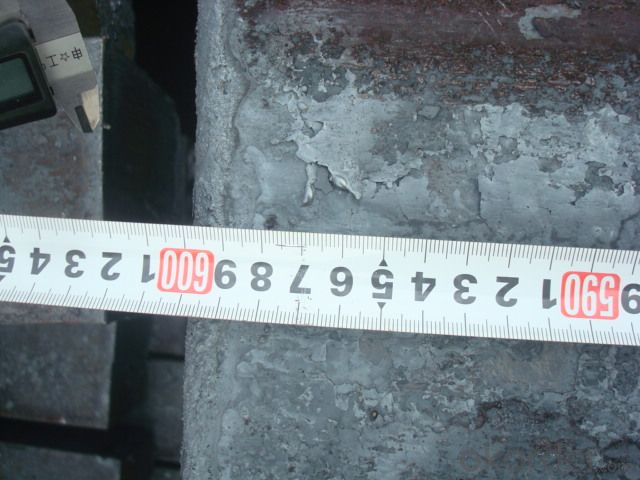
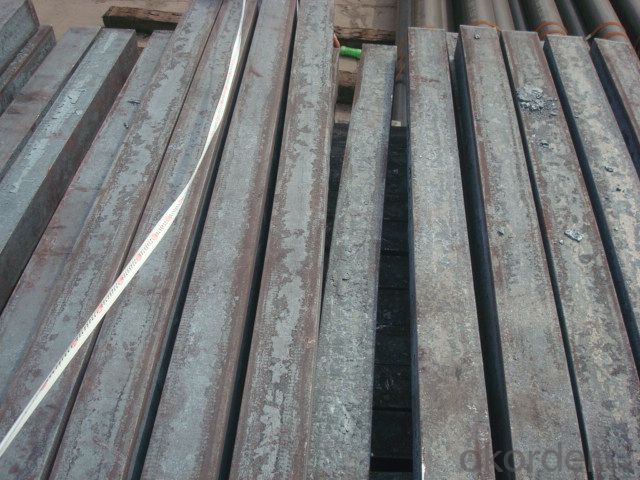
5.Usage
Billets, or ingots (as they sometimes referred to), are not of practical use until they have been formed into more functional shapes and sizes. While they have already been put in the furnace, they still require a series of shaping and molding procedures such as hot and cold working, milling and cutting before they are sold in hardware stores, or used for different applications. The unformed billets, however, can be used in striking currency such as coins and as reserves, similar to gold bars.
6.Detailed specification
Hot rolled billet steel
Size: 50x50mm-180x180mm
Steel Grade: 3SP, 5SP,Q195,Q235,Q255,Q275 Length:3m-12m
MOQ: 1000MT/size
Payment term: TT or LC
Packing: in bulk , bundle
Shipment: by container , bulk vessel
Packaging Details: bundles with steel strips or as customers's requirements
Delivery time: 15-30 days after the deposit
Loading port:Tianjin, or other port China
Origin : China
Inspection:Third party inspection before loading.
- Q: What are the different types of steel billet packaging materials?
- When selecting the suitable packaging material for steel billets, it is crucial to take into account the unique characteristics and benefits of the various options available in the market. The following are some commonly utilized packaging materials for steel billets: 1. Wooden Crates: Renowned for their durability and strength, wooden crates are a favored choice for packaging steel billets. They offer exceptional protection against external impacts and are particularly suitable for long-distance transportation. 2. Steel Strapping: Frequently employed to bundle steel billets together, steel strapping is a robust and secure packaging material. It boasts high tensile strength and resistance to breakage, ensuring that the billets remain intact during handling and transportation. 3. Plastic Wrapping: As a cost-effective and lightweight packaging option, plastic wrapping provides ample protection against moisture and dust, preventing any potential damage to the billets. Moreover, it is easily applicable and removable, rendering it a convenient choice for packaging. 4. Steel Framing: For larger and heavier steel billets, steel framing serves as a heavy-duty packaging material. It offers maximum protection and stability during transportation, effectively minimizing the risk of deformation or damage to the billets. 5. Cardboard Boxes: Smaller steel billets frequently find themselves packaged in cardboard boxes. These boxes are lightweight, easy to handle, and offer sufficient protection against minor impacts and scratches. Additionally, cardboard boxes can be customized in various sizes and shapes to accommodate different billet dimensions. 6. Stretch Film: Stretch film, a flexible packaging material, is commonly employed to wrap steel billets. It provides exceptional protection against moisture, dust, and scratches. Furthermore, stretch film imparts a certain level of stability to the billets, preventing any movement during transportation. When selecting the appropriate packaging material, it is crucial to consider the specific requirements of the steel billets, including size, weight, and transportation conditions.
- Q: How do steel billets contribute to the manufacturing of renewable energy systems?
- The manufacturing of renewable energy systems heavily relies on steel billets, as they serve as the necessary foundation for various components. These billets are essentially semi-finished steel products that are cast into specific shapes, making them highly adaptable and versatile for different renewable energy applications. Wind turbines, for instance, require a sturdy and stable structure to support the blades and generator. Steel billets are used to construct the tower, which acts as the backbone of the wind turbine. These towers must endure harsh weather conditions and bear the weight of the blades, making the strength and durability of steel crucial. Similarly, solar energy systems, particularly photovoltaic (PV) panels, also rely on steel billets. Steel frames are utilized to provide structural support for the PV panels, ensuring they are securely mounted and capable of withstanding various environmental conditions. Additionally, steel billets are used in the production of solar trackers, which optimize the positioning of PV panels to maximize energy generation by tracking the sun's path throughout the day. Moreover, steel billets contribute to the manufacturing of hydroelectric power systems. In hydroelectric power plants, large turbines are utilized to convert the energy from flowing water into electricity. These turbines necessitate strong and reliable components, such as shafts and mechanical parts, which are often made from steel billets. The high strength and corrosion resistance of steel make it an ideal material for these applications. Furthermore, steel billets are employed in the production of energy storage systems, like batteries. These billets are used to create durable and secure enclosures for the batteries, ensuring their protection and safe operation. Steel's ability to withstand high temperatures and resist fire makes it a suitable choice for battery housing and containment. In conclusion, steel billets are indispensable in the manufacturing of renewable energy systems, providing the required strength, durability, and versatility for various components. Whether it is wind turbines, solar panels, hydroelectric turbines, or energy storage systems, steel billets play a critical role in enabling the reliable and efficient generation of renewable energy.
- Q: What are the potential applications of steel billets in the medical sector?
- Steel billets have a wide range of potential applications in the medical sector. One of the key uses of steel billets is in the manufacturing of medical instruments and surgical tools. The high strength and durability of steel make it an ideal material for producing instruments that require precision and reliability. From scalpels and forceps to bone saws and orthopedic implants, steel billets can be transformed into various medical tools that are essential for surgeries and procedures. Additionally, steel billets can be utilized in the production of medical equipment such as hospital beds, wheelchairs, and stretchers. These products require a sturdy and robust material to ensure patient safety and comfort. Steel provides the necessary strength to support the weight of patients and withstand regular usage, making it an excellent choice for such applications. Furthermore, steel billets can be used in the construction of medical facilities and infrastructure. Steel is known for its structural integrity, making it suitable for building hospitals, clinics, and research laboratories. Steel structures offer resistance against earthquakes, fires, and other natural disasters, ensuring the safety of both medical personnel and patients. Moreover, steel billets can be employed in the manufacturing of medical storage systems and cabinets. These storage solutions are crucial for maintaining a sterile and organized environment, preventing cross-contamination, and ensuring the proper storage of medical supplies and equipment. In conclusion, steel billets have numerous potential applications in the medical sector. From the production of surgical instruments and medical equipment to the construction of medical facilities, steel's strength, durability, and reliability make it an invaluable material in enhancing patient care and safety.
- Q: What is the role of steel billets in the automotive industry?
- In the automotive industry, steel billets play a crucial role in the production of various components and parts for vehicles. Steel billets are essentially semi-finished steel products that undergo further processing to be transformed into the desired shape and size required for automotive applications. One of the primary uses of steel billets in the automotive industry is for the production of engine and transmission components. These include crankshafts, connecting rods, camshafts, gears, and other parts that require high strength and durability. Steel billets are used as raw material for forging or casting these components, ensuring they can withstand the rigorous demands of engine operation. Another significant application of steel billets in the automotive sector is for the production of structural components. These components, such as chassis frames, suspension parts, and body panels, require high strength and stiffness to provide safety and rigidity to the vehicle. Steel billets are processed through various techniques like hot rolling, cold rolling, or extrusion to produce the necessary forms and shapes needed for these structural components. Moreover, steel billets are also utilized in the manufacturing of fasteners like bolts, nuts, and screws, which are essential for assembling different parts of the vehicle. These fasteners need to possess excellent tensile strength and resistance to vibration and corrosion, making steel billets an ideal choice for their production. Additionally, steel billets find application in the production of various other automotive components, such as axles, wheel hubs, brake discs, and steering system parts. All these components require the superior mechanical properties offered by steel billets, including high strength, toughness, and resistance to wear and tear. In summary, steel billets play a vital role in the automotive industry by serving as the raw material for the production of engine and transmission components, structural components, fasteners, and other crucial parts. Their exceptional mechanical properties make them an ideal choice for applications that demand high strength, durability, and reliability, ensuring the safety and performance of vehicles on the road.
- Q: Are steel billets used in the production of automotive parts?
- Yes, steel billets are commonly used in the production of automotive parts. Steel billets are semi-finished products that are typically used as raw materials in various manufacturing processes. They are often forged or rolled into the desired shape and size to create automotive components such as engine parts, axles, gears, springs, and chassis. Steel billets offer excellent strength, durability, and formability, making them an ideal choice for producing automotive parts that require high performance and reliability.
- Q: What are the different types of steel billet machining processes?
- In the industry, various steel billet machining processes are utilized. Among the most commonly employed methods are as follows: 1. Turning: By rotating the steel billet against a cutting tool, material is removed and the desired shape is achieved. This method is typically used for creating cylindrical or conical shapes. 2. Milling: Material is removed from the steel billet using a rotating multi-point cutting tool. This versatile process can be employed to fashion a range of shapes, including flat surfaces, slots, and grooves. 3. Drilling: Holes are created in the steel billet by employing a rotating drill bit. This can be done manually or through automated machines, and is often utilized to create holes for fasteners such as bolts or screws. 4. Grinding: An abrasive wheel is employed to remove material from the surface of the steel billet. This process is frequently used to achieve a smooth and precise finish or eliminate any undesired surface imperfections. 5. Sawing: The steel billet is cut using a saw blade, which can be of various types such as band saws, circular saws, or abrasive saws. Sawing is often employed to divide the billet into smaller pieces or remove excess material. 6. Broaching: Utilizing a specialized cutting tool named a broach, material is removed from the steel billet. This method is frequently applied to create internal or external features such as keyways or splines. 7. Honing: A finishing process involving the use of abrasive stones to create a smooth and precise surface on the steel billet. Honing is often employed to enhance dimensional accuracy, surface finish, and overall quality of the billet. These examples represent only a few of the diverse steel billet machining processes available. The selection of a particular process depends on the specific requirements of the project, including the desired shape, size, and surface finish of the steel billet.
- Q: How are steel billets tested for quality?
- Steel billets are tested for quality through various methods such as visual inspection, dimensional analysis, mechanical testing, and chemical analysis. Visual inspection ensures that the billets are free from surface defects, cracks, and other abnormalities. Dimensional analysis checks whether the billets meet the specified size and shape requirements. Mechanical testing involves evaluating the billets' strength, hardness, and other mechanical properties. Chemical analysis assesses the composition of the steel to ensure it meets the required standards. These comprehensive tests help ensure the quality and reliability of steel billets.
- Q: What are the different surface treatments available for steel billets?
- There are several different surface treatments available for steel billets, each serving a specific purpose and offering unique benefits. Some of the commonly used surface treatments for steel billets include: 1. Hot-dip galvanizing: This process involves immersing the steel billets in a bath of molten zinc, creating a protective coating that helps prevent corrosion. Hot-dip galvanizing provides excellent corrosion resistance and durability, making it suitable for outdoor applications. 2. Electroplating: Electroplating involves depositing a layer of metal onto the surface of the steel billets using an electrical current. This treatment can enhance the appearance of the steel while providing corrosion resistance and improving wear resistance. 3. Powder coating: Powder coating is a dry finishing process where a fine powder is electrostatically applied to the steel billets and then cured under heat. This treatment creates a durable and attractive finish that is resistant to chipping, scratching, and fading. 4. Passivation: Passivation is a chemical treatment that removes contaminants and creates a protective oxide layer on the surface of the steel billets. This process enhances the corrosion resistance of the steel and improves its appearance. 5. Phosphating: Phosphating involves applying a phosphate coating to the steel billets, which enhances corrosion resistance and improves paint adhesion. Phosphating is commonly used as a pre-treatment before painting or powder coating. 6. Shot blasting: Shot blasting is a mechanical surface treatment that involves blasting steel billets with small abrasive particles at high velocity. This process removes surface contaminants, scales, and rust, resulting in a clean and roughened surface suitable for further treatments or coatings. 7. Acid pickling: Acid pickling is a chemical treatment that removes oxide scales, rust, and other impurities from the surface of the steel billets. This treatment provides a clean and smooth surface, preparing the steel for subsequent processing or coating. These are just a few examples of the surface treatments available for steel billets. The choice of treatment depends on the specific requirements of the application, including corrosion resistance, appearance, and functional properties. It is essential to consider factors such as cost, environmental impact, and performance expectations when selecting the appropriate surface treatment for steel billets.
- Q: How are steel billets used in the manufacturing of pumps and compressors?
- Pumps and compressors rely heavily on steel billets, a crucial raw material for their manufacturing process. These semi-finished steel forms are transformed into different components and parts of these devices. To prepare steel billets for shaping, the initial step involves heating them to a high temperature to make them malleable. Once heated, the billets go through various metalworking techniques like forging, rolling, or extrusion. By subjecting them to these processes, the billets are converted into the desired shapes and sizes required for specific pump and compressor components. In pump manufacturing, steel billets are utilized to fabricate impellers, responsible for fluid movement and circulation. The billets are shaped according to the impeller design through machining or casting procedures. Similarly, for compressors, steel billets are used to create vital components like cylinders, pistons, and connecting rods, which facilitate gas compression and movement. The preference for steel billets in pump and compressor manufacturing stems from their advantageous properties, such as strength, durability, and corrosion resistance. These properties are vital for ensuring the efficiency and longevity of these mechanical devices, especially when they operate under high pressures, temperatures, and harsh working conditions. In conclusion, steel billets play a fundamental role in the manufacturing process of pumps and compressors. They provide the necessary raw material for shaping and creating various components that enable these devices to function effectively.
- Q: How are steel billets used in the production of flanges?
- Steel billets are an essential raw material used in the production of flanges. Flanges are critical components that connect pipes, valves, and other equipment in various industrial applications, such as oil and gas, petrochemicals, and power plants. To manufacture flanges, steel billets are first heated to a high temperature to make them malleable and easy to shape. They are then passed through a series of rolling mills, where they undergo hot rolling or forging processes. This helps to shape the steel billets into the desired flange dimensions, including outer diameter, inner diameter, and thickness. During the rolling or forging process, the steel billets are subjected to immense pressure, which helps to align the steel grains and improve the structural integrity of the flanges. This ensures that the flanges can withstand high pressures, temperature variations, and other challenging operating conditions that they may encounter during their service life. Once the initial shaping is complete, the flanges are further processed to refine their surface finish. This may involve machining, grinding, or polishing, depending on the specific requirements of the flange design. These additional processes help to achieve a smooth and precise surface, ensuring proper sealing and connection when the flanges are installed in a piping system. After the surface finish is refined, the flanges undergo various quality control checks, including dimensional inspections, mechanical testing, and non-destructive testing. These tests ensure that the flanges meet industry standards and specifications, guaranteeing their reliability and performance. In summary, steel billets are crucial in the production of flanges as they provide the raw material necessary for shaping and forming these essential components. The combination of high-temperature processing, rolling or forging, and subsequent finishing processes helps to create flanges that are strong, durable, and capable of withstanding demanding conditions in industrial applications.
Send your message to us
Prime Steel Billet Q275, 20MnSi, 5SP,Q235
- Loading Port:
- Tianjin
- Payment Terms:
- TT OR LC
- Min Order Qty:
- 1000 m.t.
- Supply Capability:
- 20000 m.t./month
OKorder Service Pledge
OKorder Financial Service
Similar products
Hot products
Hot Searches
Related keywords
